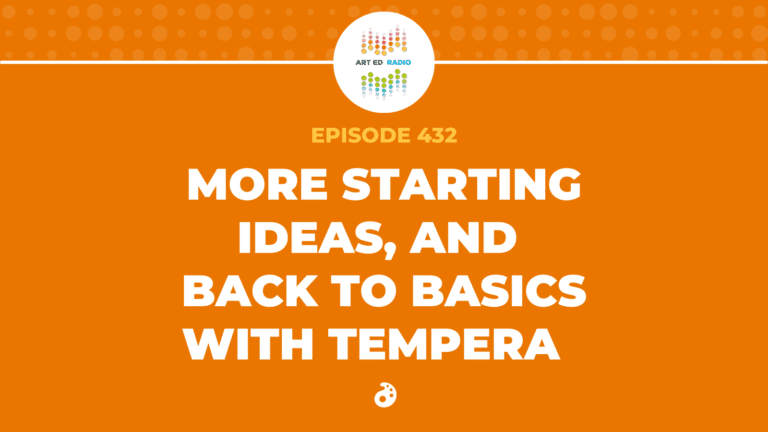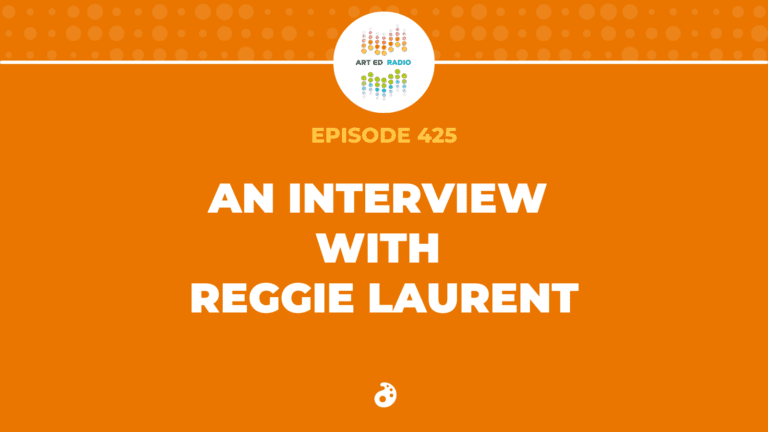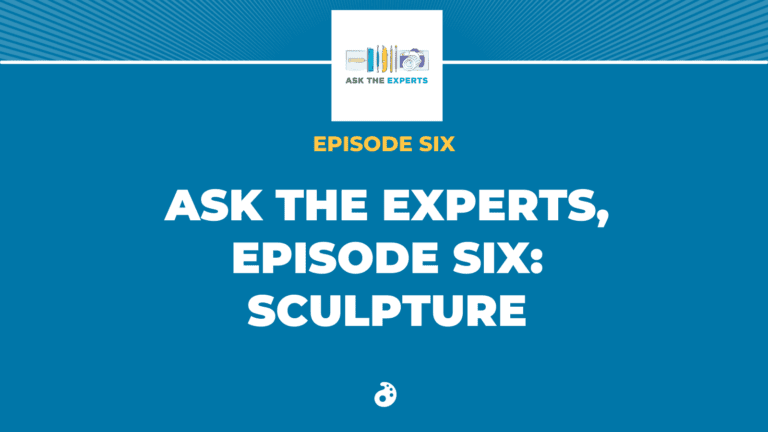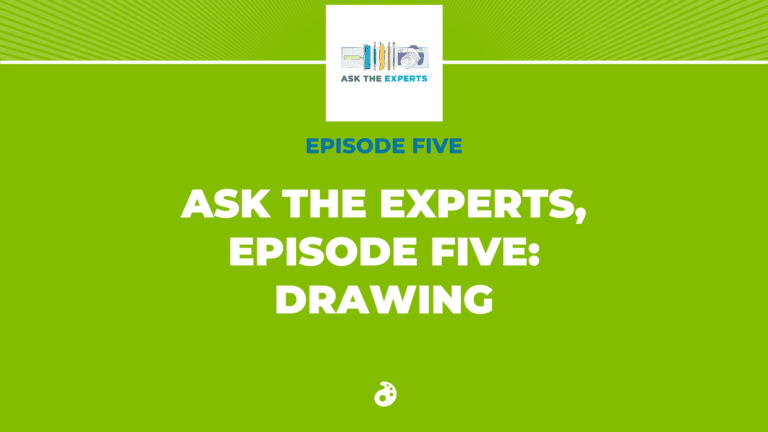In today’s episode, Candido welcomes Jess Karr to the show as they talk about how important it is to be resourceful as an art teacher. Listen as they share some ideas and experiences with resourcefulness and also talk about LEGO in the art room, their ideal setup with centers, and how to embrace working with what you have. Full Episode Transcript Below.
Resources and Links
- Follow Jess on Instagram
- How to Embrace Limitations to Tap Into Creativity
- Listen to Ep. 223 with Levar Robinson
- See AOEU’s IG Live episode with LEGO artist Ekow Nimako
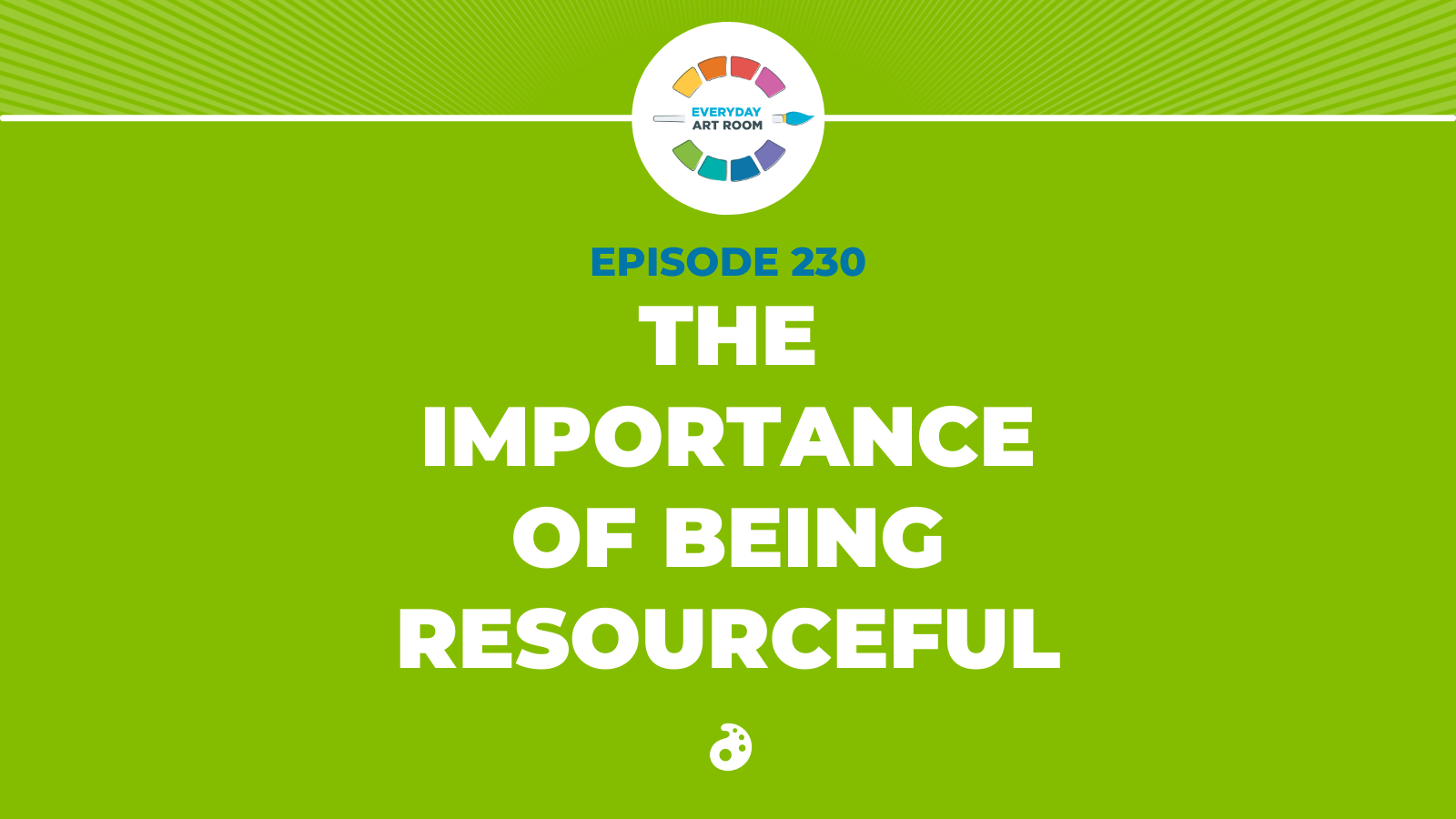
Transcript
Candido: There’s something very special about the marriage between sustainability and artmaking. That ability to reuse or repurpose material makes me feel like I’m doing good and also making something beautiful. I specifically love collage-ing with magazines and other found materials.
However, sometimes found materials are the only materials. Fortunately being creative individuals also means that we are very capable of being resourceful. Budget cuts and large classes often leave us no choice. I don’t know the full story yet, but as soon as I saw Jess Karr’s posts, featuring her students’ artwork created using Legos and printing techniques, I knew I had to reach out and bring her on as a guest. This is Everyday Art Room, and I’m your host Candido Crespo.
Jess, thank you so much for joining today.
Jess: Oh my gosh, thank you so much for having me. I am so excited to be here.
Candido: I think the most important thing first is to have the audience know who you are, where you teach, who you teach. Give us a little bit.
Jess: Sure. So I am an elementary art teacher. I teach outside of Columbus, Ohio, and I teach in a K through six building. I used to teach K through eight, all in one building. That was a lot. And before that I taught high school. So I’ve had the whole … all of the grade levels, everything. I’m also part of a education committee at our local art museum. And I’m really interested in collaborating and interdisciplinary stuff. It’s been an exciting journey. I like to put my hands on lots of different things.
Candido: Okay. I have questions, but now I have more questions.
Jess: Yeah. Okay.
Candido: So I too have had the opportunity to teach K through 12th grade and I have held no punches that 8th grade is where my heart is. Do you have a favorite?
Jess: Oh my gosh. I get that question a lot. What’s your favorite grade? The great thing about elementary is that you just get a little bit of everything. Some days I’m really jiving with my 6th graders and some days I’m jiving with my kindergarten. It just depends on the day. I do tend to find a sweet spot with 4th grade, I think, if I had to pick.
Candido: Okay. Okay. That’s actually how I end my day, this year. I end with 4th graders. Yeah, every day of the week. Okay. And the other thing is, we had an episode not too long ago, where we were talking about the relationship between museums and the classrooms. You are in an interesting position where you are doing just that. So what has that relationship been like?
Jess: So my relationship started when the museum director reached out and wanted to do a project. They had a grant. My local museum is the Springfield Museum of Art in Springfield, Ohio, and they are a Smithsonian affiliate. And they had a really great opportunity to come into our schools and teach our kids about using robotic telescopes to capture images of the cosmos. And there is an education director there who, her job is to come out and bring art into the community. And so she reached out and wanted to do this project with my kids. And so that’s how initially we got connected.
We did this really cool project, which is… Probably a topic in itself for another day, but I have … it’s an online exhibit. You can go to their website and find it there, but I stayed connected with them and they started an education committee, which is people from the community, teachers, college professors. There’s a college next to the museum. And just springing together a group of people with a common interest of supporting the arts in the community and how we can just nurture that more.
Candido: Well, you have sparked my interest and this conversation can go a totally different direction than I intended to. So I’m going to pull back. I have to pull myself back on this one for a moment and remember why I reached out to you. So let me start by asking this question. Why do you think that being resourceful is such an important art teacher quality?
Jess: Yes. Gosh, I really think it’s an innate feature that all art teachers have. I don’t know if there’s any way to really explain it. Maybe it comes from just our ability to see things differently. When we see an egg carton or a paper towel roll, or just an empty cardboard box, we can just reimagine what that could become. I think I’ve trained my son, actually, he tries to snatch cardboard from the recycling. Then when we’re taking it out to the curb, he doesn’t let me get too far with it. But I think we’re just really good at that, so…
Candido: Right.
Jess: I think it’s important for a lot of reasons in the classroom, I think that our kids pick up on it. I think that we can be really like… Don’t want our kids to waste paper, for example. We want them to really think about what they create when they’re making, but it also can be a really good thing for kids to practice, being a little bit limiting with the supplies that you have instead of just having everything at your fingertips all of the time. So yeah, I think that it nurtures creativity, also helps the environment, also helps with your budget and there’s so many reasons why we need to be resourceful and show our kids that it’s important.
Candido: Yeah. I don’t know how this was an oversight for me, but, and I guess maybe I just didn’t pay attention to this part, but truly there is a modeling aspect of it that I haven’t put much mind to it. And I think that moving forward, that’s something that I do want to be conscious of because they are watching everything that we’re doing, right? So, every one of these decisions that we make inside of the classroom, especially if we’re placing these expectations on them, like you said, we don’t want them to be wasteful with paper, but if we’re going to be taking these shipment boxes and not putting them to use, then that matters. And we could be sending mixed messages and we don’t want to do that. Right.
Jess: Right.
Candido: So outside of these found objects, sometimes we have things at home and things that are donated to us because for as much as we are called upon for favors or for materials, occasionally there are people who find ways to be supportive to our classroom. And people have been supportive to me in a bunch of different ways. How did you end up with Legos in the classroom?
Jess: Yeah, I had a parent donate them, which was wonderful. And at first I just would put them out on, we would have these art party days. I used to do a reward day for my kids. I’ve since changed my style of teaching a little bit, I don’t do that exact thing anymore. I use centers more regularly and that my Legos are part of that, but I started using them in that way. And then I realized that I could be using them in more ways than just that. So I first reused them as a way for students to create a miniature sculpture. And then they would do a little still life drawing of their Lego sculpture and we added value and that kind of stuff with my middle school kids, when I taught middle school. They were really fascinated with that because they got to play with Legos before they got into the art making.
But then I really need to find the source for this because the Lego printing was not my idea. I found it on a blog and I just knew that I wanted to try it because Legos are just very captivating, no matter what age, everyone loves to play with them. And so, yeah, I just thought I would try it and it was a little bit experimental. I just kept it simple. We just used white paint. And then I decided I was doing printmaking with my older grades. So I thought, why not give it a try with printing it too? Let’s give these kids a go with the brayers and they loved that. I was just kind of seeing what they could do, what they wanted to do. And that’s just kind of how I teach though. I just kind of get started and if it goes a different direction, so be it.
Candido: Yeah. Yeah. Oh, I’m a big fan of that. I’m a huge fan of that. I have a question. So when you’re using the brayers, are the pieces still individual or are you gluing them onto a surface or what are you doing?
Jess: Yeah, so initially I just sorted a bunch of different shapes and sizes and put them on a tray and let the kids pick. It was really clever to see what they imagined. Some of the pieces were pretty small, pretty narrow. And so they just kind of started stacking them up and creating these little handles and these little gadgets to kind of stamp with. It was so fun to watch them get into it. So they were building and printing at the same time using different surfaces, the side, the top, the bottom to create different shapes and patterns.
Candido: Okay. Okay. At the project’s completion, what was the student’s response? Once they saw their pieces complete, maybe the paint was dry. Did you get feedback from them?
Jess: Yeah. Well, printmaking is one of those things that tends to be kind of a short process, especially in the way that I was doing it. They were into it and then they were like, “okay, I’m done.” It’s like, “all right. Well, I guess we’re moving on.”
Candido: Right. Right.
Jess: So, I mean, I do a, I call it an art and share to wrap up most of my lessons and they get to talk about what they made. Some of them made creatures or like a robot kind of thing. Some of them just filled their pages with shapes and designs, so that’s really how we rounded out the lesson.
Candido: All right. So you have an experience of clay, you have the experience of creating three-dimensional sculptures, within the time span that you’ve been using Legos in the classroom. How, if at all possible, can this type of project be rolled into a steam activity?
Jess: Yeah, I really think that they kind of did it naturally. They were sculpting and building as they were printing. I think that there are a lot of mechanical kind of features visually to them, but I don’t know. I think that maybe if I used some kind of moving feature, maybe I could get the Lego wheels out and get some kind of mechanical thing going. Maybe we could make a Lego printing robot or something that might be kind of cool.
Candido: Yeah. That would be pretty neat. You mentioned centers as part of your teaching technique. Is centers like a regular thing in your classroom? And if so, what are the typical other three, that would be aligned with the Lego center?
Jess: So there are a million different ways you can use centers. And I feel like I’m just scratching the surface with them, but I kind of came upon them by accident myself. I was trying to fill a content standard and tried to demonstrate the different ways that artists find ideas or inspiration in their art and the best way that I knew how to illustrate that was just by giving the kids a chance to try different ways of making art with different inspiration starters. So I had set up my room with different centers, different station for kids to get inspired in different ways. And it was like a four week project, at the time I had my kids once a week for 50 minutes. And so after the first day, the kids kind of knew what to expect. They came in the next week and they moved to the next station and then the next week to the next station.
That was my first kind of try at it when I realized how well it worked and just the ease and the flow. I knew that I had to try it in different ways. So I’ve been exploring that. I don’t run a tab classroom. That’s not the kind of center work that I do. The kids still are mostly working under my direction. And so, for example, this week, my little kids, my K one, two they’re exploring color. So I have different art mediums set up around the room. We discuss a different component of color every day, primary color, secondary, and then we do mixing. And then I just ask them to create something with color that they’re just inspired do. Maybe they really liked the way that primary colors looked or they wanted to explore warm colors or cool colors.
And then I just kind of bebop around the room and talk to them about color while they’re exploring, so…
Candido: That’s fun.
Jess: Yeah. With Legos, I think I’m going to revisit the printing at the end of the year. My kids are kind of getting used, I think, my fingers are crossed here. We’re kind of getting into a groove. I know it’s almost the end of the year, but I feel like we’re coming out of this COVID fog a little bit and I’m starting to feel a little bit more comfortable with the way things are going. So hopefully I can get printing and Legos into some stations, into some center in the room.
Candido: Okay. I have done centers in the past, primarily with my 6th graders. And that was sort of like, I approached it almost giving them syllabus at the beginning of the quarter. And they were responsible to move themselves through the stations. And that worked out really well. I haven’t done it since, because of, well, at that time I was at middle school, so I only taught 6th grade and 8th grade. And so when the studio art kids came into 8th grade, it was free rein for them because it was at that point, it was basically a high school class for those students. But yeah, I’m a fan of stations. I also don’t run a tab class. So I definitely understand how your classroom functions.
I have an idea of, by the way that you described it. Let’s you and I play a game though, because if we did run somewhat of a tab class with stations and choice-based options, my favorite found material is magazines. Let’s see if we could come with up with four solid stations, all right? So on my station, my station one is going to be magazines and our goal is going to be… Or maybe the examples I’ll leave on the table will be a collage, just a collaged image and maybe like a decoupage box.
Jess: Oh yeah.
Candido: All right. Your turn.
Jess: Gosh, I would want to do that. I don’t no. I am totally into magazines too. The last school that I was at, the art teacher left a ton of Nat Geo magazines and it was like a gold mine. So I, yeah, I mean, okay. But if I had to pick my own, I don’t know how this would work with elementary, but when I taught high school, we had a glass kiln, and we did jewelry making. So I feel like I would really want to go back to that, wire and jewelry and glass.
Candido: Okay.
Jess: I feel like I need more of, yeah. I would like to go back to that.
Candido: Okay. I mentioned earlier in the conversation, the shipping boxes. So I think I would go with probably cardboard sculpture station. Yeah.
Jess: Yeah.
Candido: And show them what it would be like. Maybe my examples would be something vertical and then something layered, probably like that approach.
Jess: Oh, nice.
Candido: Oh you have one more.
Jess: That’s good. Okay. So I really love being outside. I feel like if I could somehow have a patio on my art room, I would just have an outdoor center and just make nature art or art with natural objects.
Candido: Okay. So we need a garage-type classroom where the door opens up and we have access to the outdoors, preferably facing a forest.
Jess: Yes. Yes. Easy peasy. We can make that happen.
Candido: Ultimately, our conversation is this, we’re talking about how resourceful we are, whether we’d like to be or not. What other materials have you found yourself having to be innovative with in your classroom?
Jess: Well, I did at one point have, I called it… I don’t know if I came up with this name or the kids did, but I had this box and it was labeled trash to treasure and the kids and I would just, we would just bring in bags. I mean, you know how it is when you’re a teacher, you bring in bags of just random stuff, right? And we would just fill it up and the kids would just go to town, making art like purses and pencil holders and just out of stuff that we would normally throw away and they just live for it. That’s probably one of the coolest things, because it’s so easy for me. They just come up with these ideas. I literally don’t need to do anything
Candido: Before you continue to list. This is applicable for my classroom as well. I recently did a project where our draw, so I kind of draw in a lot of my lessons. That’s my favorite type of art and so my students know that. And so that’s something that I’ve really work with them on. So we drew a helmet, an astronaut helmet. They designed it, personalized it, colored it, et cetera. We cut it out. And then when they glued it on that second surface, I gave them access to something very similar like a trash treasure box. And they were able to create their environment, their galaxy, their space of where this helmet is located and what’s happening. And it was quite a, every project was significantly different because like you said, if we give them the tools to allow them to explore and we allow them to do that, we can end up with some terrific projects. So if a teacher is listening and doesn’t have this kind of trash treasure box inside their classroom, consider it, you might be able to do something wonderful with it.
Jess: Oh yeah, absolutely. During remote teaching, I had my students just gather whatever they could find in their house. My example was just my son’s piggy bank and I just dumped out all the coins and I just started playing with coins and started just making symmetrical shapes and stacking them up, sorting them by color. I had at one point a box of rocks in my classroom and the kids would just, literally a box of rocks and they’re happy with that. And I just think that it’s important just to, as we said in the beginning, just try to nurture that. It doesn’t have to be complicated, just whatever you can find, you can play with, you can make art with it.
Candido: Right. Right. Okay. Have you ever created artwork or personal artwork using file materials?
Jess: In college, I… Yeah, this is a good story, but it ends sad, unfortunately. I spent so many hours making this portrait, this collage portrait out of magazines, and it was beautiful. I mean, out of anything that I had made up until that point in my life, I just loved it. And my professor told us to come and pick up our work between this time and this time on a certain day. And when I went there, mine was not there. And I was devastated. I emailed my professor. I called, I mean, someone took it. Someone took my artwork and I just will never come back from that, so that has stuck with me. And I will never do that to my kids. I will never do that to my kids.
Candido: I’m sorry, I triggered that memory.
Jess: That’s okay.
Candido: Okay. And I found broken pieces of a mirror and I created a painting out of that. And I made each one of the shards of glass, of the broken mirror, they were acting as raindrops and so…
Jess: Oh, wow.
Candido: It was pretty illustrated but it wasn’t realistic, the cloud, but yeah, a friend of mine, as soon as I mean, I might have glued the last piece on and a friend of mine just purchased it. She was just like, “I love this thing. This is just…” And to date, she still has it hanging on one of her walls and this piece was a while back already. But, yeah, that’s what, so… I love it, personally, the idea of, I like the challenge of it too, where it’s just like you don’t have the control and you sort of have to turn this thing and give this thing new life, repurpose it.
I recently heard a podcast where the guest, her name, her name was Selena Tripp. I’ve never heard of her prior to the podcast, but I was listening to her on a podcast. And she’s been challenging herself in a way that, I’m not sure if I could do it. Before she’s coming up on 10 years now and this entire time she hasn’t introduced any new materials into her studio. So all the work that she has created and she does predominantly animation. So she’s doing a lot of photo and video work, but yeah, no new material. So whatever she does, it’s painted over.
Jess: Wow.
Candido: She has run out of colors, certain colors, so she has to adapt whatever she has. And her story is so fascinating. In the conversation, I think she mentioned that when she hits a 10-year mark, she actually has in storage a box of materials that her mom left behind. And so that’s the material she’s going to introduce. How cool is that?
Jess: Oh my goodness. I mean, what a story, what an artist. I mean that… Oh, that is amazing. I love that.
Candido: So yeah, if anybody wants to look her up, or her name is Selena Tripp and that just the concept alone is just so fascinating to me. All right. My last question for you, Jess. A first-year teacher has received a really small budget going into their second year of teaching and is at an absolute loss of what to do. How would you explain what we discussed here? How would you explain and tell that young teacher how to be resourceful?
Jess: Wow. Yeah, that’s tough because already as a, I mean, I’m just putting myself back into the first-year teacher shoes and there’s already so much on your mind, you’re coming off fresh of college and all of these idealistic expectations. And now we have social media. That wasn’t a thing when I started and you see all of these picture-perfect things, I would say, just embrace what you have. I mean, focus on what you do have. I think that’s important in life too. I mean, I think that building a community around it, maybe getting your kids to start collecting cereal boxes and going into the copy room and taking things out of the recycle bin. I mean, I’ve been there. I do that. And I do have resources. I think it’s still important to think. Try not to let anything go to waste and you learn pretty quick when you have a small budget, what works and what doesn’t and you get to train your kids pretty well. And that’s not a bad thing. I think that it could be useful in a lot of ways.
Candido: Right. So here’s what I would tack onto that. One, I’d probably have them understand that for some of us veteran teachers, we’ve had the ability to accumulate materials as the years have gone on. So buying in bulk and being able to hold onto, and then it looks like we’ve had this big budget along, but really what we were able to do was just configure a way so we would get to the point where we weren’t, so, driven mad about it. I would also tell a new teacher to brace themselves because if they think that this one is low, there might be an even lower one coming down the pipeline that there is really going to be shocking.
And then the last thing is this the same way you and I have found each other, social media. It’s such a powerful tool. And so if you put out an image that says, I have this material, there’s a really good chance that there’s going to be another teacher that’s going to find you and tell you exactly what you could do with that thing. So I would encourage all new and youthful teachers who are at a loss, even some veterans. I mean, if you find yourselves in a new situation, in a new school with a lower budget, and you’re starting from scratch all over again, rely on the community of our teachers that we didn’t always have and you know this.
You’re 13 years into the career or 15 years into the career. Earlier on, it was just, you could tap into the people who were in your district, but now that’s no longer the case. You and I have been connected four months now and we don’t live next to each other. We don’t attend the same professional developments. So, yeah. Jess, thank you so much for making the time to share your project, share your story with us. It means a lot.
Jess: It was truly my pleasure. I had so much fun chatting with you and talking about the stuff that we love, what’s better, right?
Candido: After seeing Jess’s post, I sent a building wide email, asking my colleagues to donate any Legos they’re looking to dispose of. And I received some, I’m excited to try this lesson and experiment with all the possibilities. If you’re looking for additional resources on this topic, first, I suggest you follow our previous guest Levar Robinson. He’s pretty much a guru on this stuff and actually Lindsey McGinnis has wrote an article on him titled, How To Embrace Limitations To Tap Into Creativity With Your Students. Thanks for listening to Everyday Art Room. I hope you’ve learned enough to want to know more. Catch you next week.
Magazine articles and podcasts are opinions of professional education contributors and do not necessarily represent the position of the Art of Education University (AOEU) or its academic offerings. Contributors use terms in the way they are most often talked about in the scope of their educational experiences.
